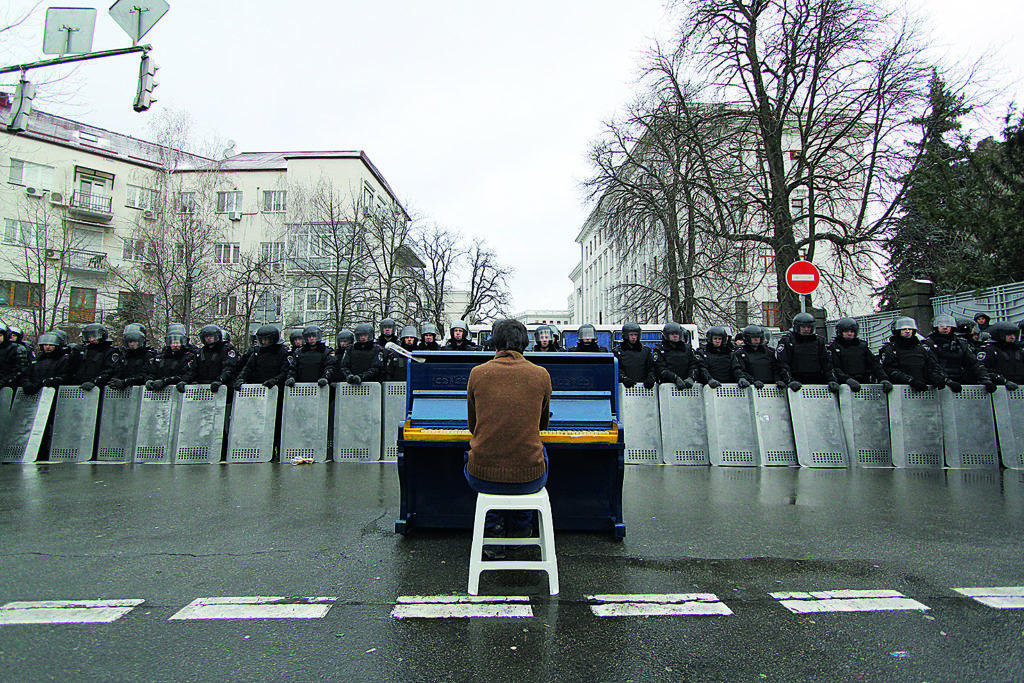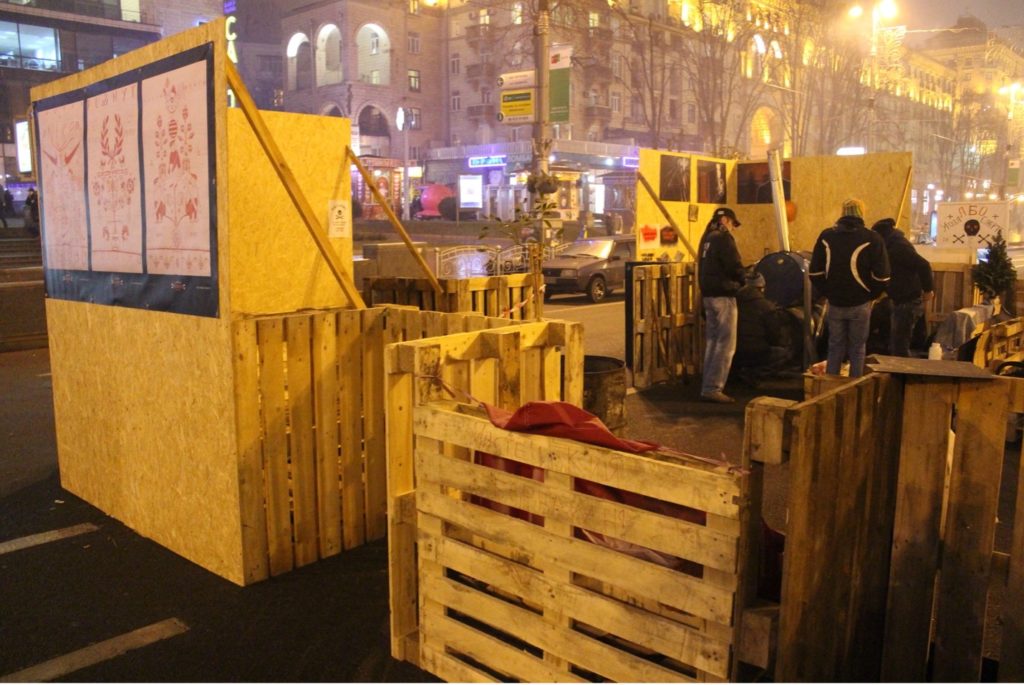The Revolution of Dignity in Ukraine (2013-2014), 2021
The Revolution of Dignity (November 21, 2013- February 22, 2014) has been the most dramatic turbulence in recent Ukrainian history so far. It is assumed that the revolutionary events had two phrases. The Euromaidan (November 21-29, 2013) was a relatively peaceful stage. People went out on the streets to protest against President Viktor Yanukovich’s refusal to sign the political association and free trade agreement with the European Union at a meeting of the Eastern Partnership in Vilnius, Lithuania. This decision implied closer alliance with Russia.
At first, the protests gathered momentum on social-networking sites and were actively supported by the creative people. At this stage, the protest was entirely peaceful, and it looked like 2013 would follow the same pattern as 2004. The so-called “Euro-Revolution” initially consisted of lively dancing, joyful meet-ups between members of the art scene in the spirit of the Occupy movement, and discussions about the fate of humanity over hot cups of tea and revolutionary sandwiches. Oleksandr Roitburd was one of the first artists to step out onto this carnivalesque Maidan. He took an active part in the first wave of protests, which were joyful, pacifist, and small. Roitburd’s activity on Facebook became so popular that in just a few days he became a hero of the Maidan and the intellectual leader (or ruler!) of the creative class, which actively supported the idea of European integration on both social-networking sites and the Maidan itself.
The protests of 2013 were not limited to a harmless carnival, and on the night of 30 November the government began brutally dispersing students on the Maidan. The next day proved to be a turning point when a huge crowd of intellectuals gathered on Mykhailivska Square and barricades were quickly erected on the Maidan. Within the first few days of the protests the Straik-Plakat (Strike-Poster) group appeared on Facebook, where open-access revolutionary protest posters created by members of the country’s creative community were uploaded throughout the following months. The group’s posters included a portrait of Ukraine’s president with a red clown’s nose as well as the poster “I am a drop in the ocean,” which was a reference to the “warm ocean strategy” that became popular in the early stages of the revolution and denoted a peace-loving and positive protest.
After the students were violently dispersed, a new stage of the Maidan protests began, marked by the construction of ultra-aesthetically pleasing ice barricades and the assembly of a national “art piece” which became known as Yolka (Christmas tree in Russian) in form of an Internet meme. A characteristic feature of the 2013–2014 Maidan protests was their complete aestheticization. The protest city behind the barricades became an all-encompassing art installation clearly visible from the staged media shots taken by the revolution’s foot soldiers. Overall, the Maidan’s aesthetic invoked a dystopia that was futuristic, yet harkened back to medieval times. Indeed, cultural theorists led by Umberto Eco had only recently been predicting the arrival of such a time.
Naturally, the protest prompted a wave of conceptual creativity from the Ukrainian populace. Over the course of two months, a whole array of art actions was staged on the country’s central square, several of which were seen by the entire world. As a rule, the organizers of these art actions were members of the public, not “professional” artists, but people who had chosen artistic methods to convey and share their civic position. On December 7, 2013, Markiyan Matsekh from Lviv did one such art action that garnered a lot of publicity. He played a piano outside the office of the President of Ukraine. The photograph of a young man playing Chopin in front of a wall of state security forces set the internet alight and became a symbol of peaceful civic protest.

On 29 December 2013, another celebrated civic stunt entitled “The Kingdom of Darkness Is Surrounded” was held in Kyiv’s government quarter. The aim of the stunt organized by the Maidan’s Civic Sector was to hold a mirror up to those defending power, and to redirect the security forces’ negative energy back onto them. The stunt’s participants carried mirrors and pointed them towards the row of police officers guarding the government quarter, a part of the city, which, following the dispersal of demonstrators, had become a true symbol of the kingdom of darkness.

At the very beginning of the protests, a group of young artists emerged. The group’s most active members were Oleksa Mann, Ivan Semesiuk, and Andrii Yermolenko. In 2013, they had announced their arrival to the art scene with their shocking pieces, which played ironically with the most unsightly aspects of new Ukrainian reality, that is, the thugs, schmucks, and other low-life inhabitants of the edges of large Ukrainian cities. Semesiuk and his fellow artists had also created slogans such as “Freedom or death” or “Freedom or everyone can go f*ck themselves” long before the artists re-appeared with full force on Kyiv’s Maidan. These old slogans were defined by their national anarchist flavor and abundance of ironically employed foul language. They also added a certain color to the bright and memorable texts that Semesiuk and Mann regularly posted online. For those artists who never abandoned the barricades on the Maidan, not even in the bloodiest days of the protests, this was their time to shine. They even organized an improvised gallery and communications center right on the edge of the Maidan, where Khreshchatyk Street runs past the square. They named the communication center the Artist’s Barbican. The Artist’s Barbican was hastily built from industrial pallets and sheets of plywood and was, for a long time, the center of gravity for the creative youth that gathered on the square. The improvised street gallery showed the work of Mann, Semesiuk, Yermolenko as well as Vitalii Kravets, Lena Dubrova, and other artists. A flash-fiction festival and lectures were also held there. It was also worth noting that the Barbican had its own stove, which, when it was freezing cold, proved to be quite an important factor in attracting those concerned with creating art.

One of the key features of the Maidan protests was their focus on the media. Never before had political events in Ukraine, nor indeed the documentation of public unrest, been so aestheticized. Thousands of photographs were taken on the Maidan during some of the fieriest moments of the protests. The fiercer the clash became between the government and the protestors, the more striking and cinematographic its documentation became. As a result of the Maidan’s strange gravitational pull, the protests saw the creation of a significant video and photo archive, with images taken and footage recorded during the protests’ saddest and ugliest moments. Eminent artists, alongside news agency photographers and simple amateurs, all fought for the perfect shot. Those who succeeded in capturing the most interesting photographs from that winter included Serhii Bratkov, Boris Mikhailov, Vladyslav Krasnoshchok and Serhii Lebedynsky, Oleksandr Burlaka and Sasha Kurmaz, Oleksii Salmanov, Kostiantyn Strilets, and Oleksandr Chekmenev.[1]
The shock caused by the bloody events at the end of Maidan protests, the Russian annexation of Crimea, and the beginning of the war in the Donbas have become a traumatic experience for the Ukrainian artistic community. For many artists who took active part in the Maidan events, this period was the time of a post-revolutionary “hangover,” an emotional drama that was hard to express in a single artwork. To others, on the contrary, this very period gave impetus to work on new subjects, problems, and projects. At this time, a noticeable phenomenon was the documentaries about the Maidan and further events made by film director and artist Oleksiy Radinsky, an activist of the Visual Culture Research Center (VCRC). Particularly important was his film People Who Came to Power, 2015, co-authored with the Slovakian artist and filmmaker Tomáš Rafa, which focused on the initial stages of the conflict in Eastern Ukraine.
Nikita Kadan’s project “The Possessed Can Witness in the Court” exhibited at the Ukrainian National Art Museum in 2015 was one of the most powerful artistic statements on the war in the Donbas, mimicking archival arrangements, Kadan shelved various items taken from the Museum’s collection about the region’s Soviet history. The Donbass has been caught up in a violent conflict since 2014. Taken out of the ideological narrative, these objects look preposterous and melancholic. The shells that landed on the territory of Eastern Ukraine in 2014–2015 were also exhibited at the Museum’s staircase landings. Mykola Ridnyi showed his programmatic work The Blind Spot, 2014 in Okwui Enwezor’s curatorial project at the Venice Biennale in 2015. The artist took the images from media reports about the war in Eastern Ukraine and painted them black, leaving just a small spot intact, which made the viewer feels the limitedness and irrelevancy of their vision of this fragment of reality. At the same Biennale, the Ukrainian pavilion exhibited yet another strident artwork about the East Ukrainian war, a video installation by the Open Group Synonym For “Wait”. The artists put surveillance cameras in the houses of people who left for the war. The cameras showed real-time footage of the soldiers’ relatives waiting for their family members to return home.
At this period, a new generation of artists made its debut on the art scene. Its most interesting representative was Roman Mikhaylov from Kharkiv. In 2014, the artist created Shadows–an installation showing scorched shipwrecks. In this work Mikhaylov reflects upon the Russian annexation of Crimea and the destiny of the Black Sea Navy Fleet that had been the bone of contention between Russia and Ukraine for decades. Another important project of Mikhaylov began as a performance at the Maidan, where the artist hot-smoked the paper for his graphic works from The Breath of Freedom series, 2013 over the burning barrels in the tent camp behind the barricades. Later, this series developed into gigantic sheets of scorched paper: Fragility (at the façade of Église Saint-Merri in Paris, 2014), Imprints of Reality (2015), etc.
One of the most politically engaged female artists of the post-Maidan epoch is Maria Kulikovska. Her performance at the 2014 Manifesta in St. Petersburg became enormously famous. To protest the Russian annexation of Crimea and the war in Eastern Ukraine, she wrapped herself up in the Ukrainian flag on one of the Hermitage’s staircases. No less famous was her action The Crimea Float Board (2016), during which the artist drifted on a float board down the Dnieper river without any food reserve in order to emphasize the vulnerability of people who lost their homes and native land after the annexation of Crimea. Before the Maidan Revolution, Kulikovska started a series that featured the castings of her own body. Her works from this series were exhibited, among others, at the only contemporary art institution in Donetsk, the Izolatsiya Art Centre. During the armed conflict in Donetsk, the factory that housed this institution was taken over by separatists who turned the art center into a prison for pro-Ukrainian people and “executed” Maria Kulikovska’s sculptures by using them for target practice. In 2015, in remembrance of this event the artist staged her performance Happy Birthday at the Saatchi Gallery in London. In the course of this performance, the naked artist hammered down the soap castings of herself as an answer to the separatists who destroyed her artworks.

[1] A research of Ukrainian art during and after the revolution of 2013-2014 was made by a Polish scholar and curator Ewa Sułek. Sułek, Ewa. Chłopak z Pianinem. O Sztuce i Wojnie Na Ukrainie. PWN (Polish Scientific Publishers), Warsaw, 2018.